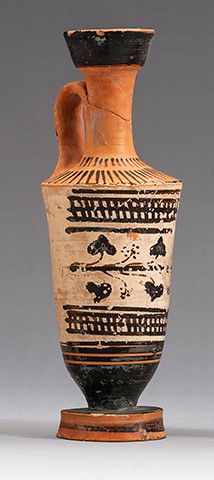Acquisition number: 1973.07
Attic Black-Figure Lekythos. The neck is broken and rejoined but the vase is otherwise intact. The mouth is painted inside and out but the top of the lip is reserved and reddened. The outer face of the handle is black. On the shoulder are strokes (degenerate lotus buds) with bars above. The body is white-ground and decorated with ivy between lattice. On the lower wall are two ‘wet incised’ lines. There is a band on the vertical face of the foot. The underside is reserved. All the reserved surfaces are reddened.
Title: Attic Black-Figure Lekythos - 1973.07
Acquisition number: 1973.07
Attribution: Beldam Painter.
Author or editor: J.R. Green
Culture or period: Classical Greece.
Date: Mid 5th century BC.
Material: Clay - Terracotta
Object type: Pottery - Black-figure
Dimensions: 53mm (w) × 150mm (h)
Origin region or location: Greece
Origin city: Athens.
Display case or on loan: 3
Keywords: Greek, Attic, Black Figure, Beldam Painter
J.R. Green with B. Rawson, Catalogue of Antiquities in the Australian National University, A.N.U. (Canberra, 1981) 28. Beazley Archive Pottery Database 7657. E. Serbeti, “Δεκαπέντε αττικές λήκυθοι από την Ηλίδα”, in: A. Alexandri and I. Leventi (eds), Καλλίστευμα. Μελέτες προς τιμήν Όλγας Τζάχου-Αλεξανδρή (Athens 2001).
1973.07
Attic Black-Figure Lekythos
Cyril Henry Leach Bequest, by courtesy of the Trustees of the British Museum. Ht 15cm; diam. 5.3cm.
The neck is broken and rejoined but the vase is otherwise intact. The mouth is painted inside and out but the top of the lip is reserved and reddened. The outer face of the handle is black. On the shoulder are strokes (degenerate lotus buds) with bars above. The body is white-ground and decorated with ivy between lattice. On the lower wall are two ‘wet incised’ lines. There is a band on the vertical face of the foot. The underside is reserved. All the reserved surfaces are reddened.
This lekythos is of a type produced in quantity in the workshop of the Beldam Painter around the middle of the fifth century BC; they seem to have been manufactured primarily for use in graves - compare those from the Kerameikos cemetery in Athens published by B. Schlörb-Vierneisel, Mitteilungen des Deutschen Archäologischen Instituts, Athenische Abteilung 81, 1966, Beil. 26, 3 or the variants Beil. 26, 2. In addition to the characteristic pattern-work, note the typical ‘wet-incised’ lines on the lower wall. For the shape compare also the companion piece 1973.08, the figured lekythos 1973.09 and the palmette lekythos 1965.04 which was probably also made in the same shop.
For similar pattern-lekythoi of the Workshop of the Beldam Painter, see C.H.E. Haspels, Attic Black-figured Lekythoi (Paris 1936) 181ff., C. Boulter, Hesperia 22, 1953, 71 no. 21, and D.C. Kurtz, Athenian White Lekythoi (Oxford 1975) 153-155 and pl. 70, 5-6. B. Philippaki suggested that some pattern lekythoi may even run as late as the end of the fifth century: Archaiologike Ephemeris 1953-54, iii, 108. See also the contexts for such lekythoi in Corinth XIII. The North Cemetery (Princeton 1964). For another recent publication of such pieces, see E. Serbeti, “Δεκαπέντε αττικές λήκυθοι από την Ηλίδα”, in: A. Alexandri and I. Leventi (eds), Καλλίστεθμα. ΜελέτεςπροςτιμήνὈλγαςΤζάκου-Αλεξανδρή(Athens 2001) 161-198, esp. 194-198 nos. 13-15.
J.R. Green with B. Rawson, Catalogue of Antiquities in the Australian National University, A.N.U. (Canberra, 1981) 28. Beazley Archive Pottery Database 7657. E. Serbeti, “Δεκαπέντε αττικές λήκυθοι από την Ηλίδα”, in: A. Alexandri and I. Leventi (eds), Καλλίστευμα. Μελέτες προς τιμήν Όλγας Τζάχου-Αλεξανδρή (Athens 2001).
